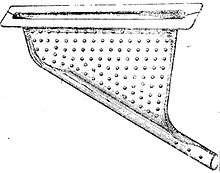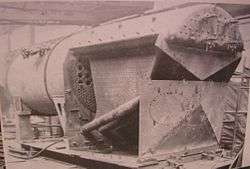Thermic siphon


Thermic siphons (alt. thermic syphons) are heat-exchanging elements in the firebox or combustion chamber of some steam boiler and steam locomotive designs. As they are directly exposed to the radiant heat of combustion, they have a high evaporative capacity relative to their size. By arranging them near-vertically, they also have good water circulation by means of the thermosyphon effect.
History
The concept of a self-circulating thermic syphon began with stationary boilers and relatively simple Galloway tubes. They reached their peak in steam locomotive boilers, where the complexity of a syphon was justified by the need for a compact and lightweight means of increasing boiler capacity. One of the best-known forms for locomotives was invented and patented [1] by the American locomotive engineer John L. Nicholson.[2] The Nicholson form combined a complex shape that provided more heating area in a given space than did the earlier tubes and funnels, yet was simple to make, being folded from a single sheet of steel.
Flued boilers
.jpg)
The first high-pressure boilers were a large drum with a central flue, such as the Cornish and Lancashire boilers. Simple tubes were inserted across this flue.[3]
Steam locomotives
Located within a steam locomotive firebox, the thermic siphon is a funnel-shaped steel fabrication that connects the bottom of the throat sheet (the front wall of the firebox) with the crown sheet (the roof of the firebox). Feed water flows upward through the siphons from the boiler barrel. By exposing the water to the heat of the firebox, thermic siphons increase thermal efficiency and help to improve water circulation in the boiler through ensuring more uniform temperatures within it. Fresh cold water introduced from the injectors is pre-heated by passage through the siphons before arriving at the crown sheet, the hottest part of the boiler. Thermic siphons are located in the body of the firebox or, if applied, in the combustion chamber. The technique has been utilised on several designs. In Great Britain, the principal advocate of this technology was Oliver Bulleid, with the concept used in his Merchant Navy, Leader class, West Country and Battle of Britain Classes.
Feedwater heater
A thermic siphon is an integral part of the boiler and is quite different from a feedwater heater, which is an external accessory.
See also
References
- ↑ Thermic Siphon for Locomotives - Patent 1679051
- ↑ American Locomotive Engineers
- ↑ Hills, Richard L. (1989). Power from Steam. Cambridge University Press. pp. 134–135. ISBN 0-521-45834-X.
External links
| Wikimedia Commons has media related to Thermic syphons. |